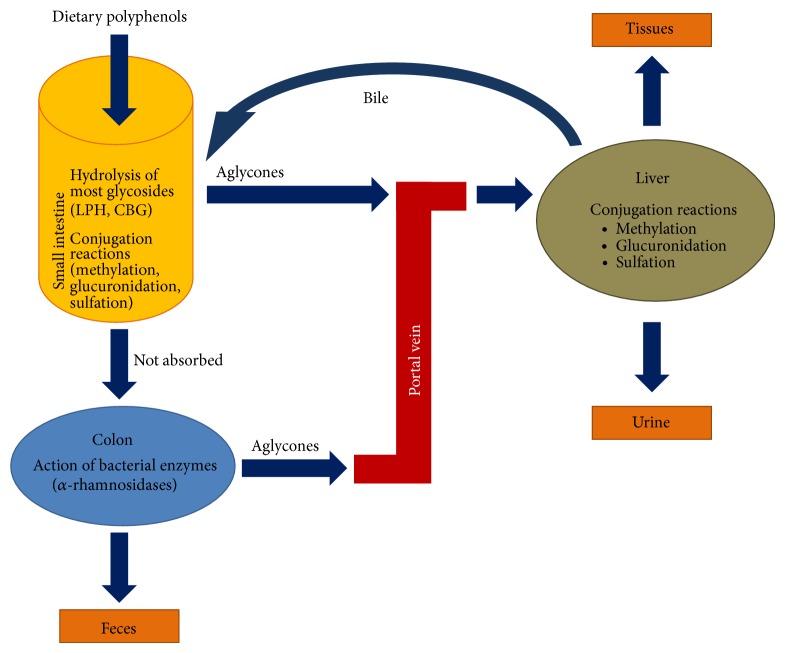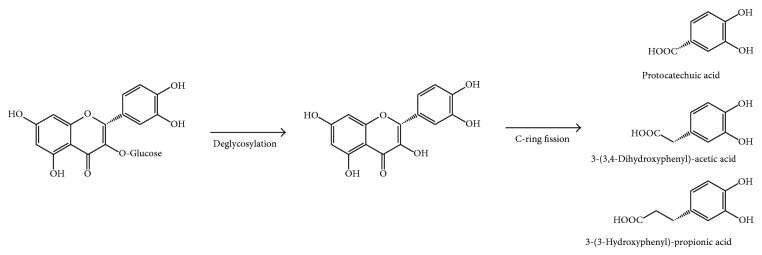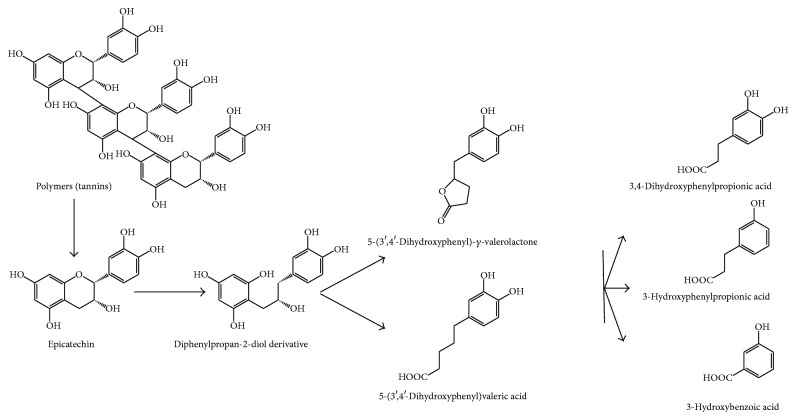¡¡
Biomed Res Int. 2015; 2015: 905215.
Bioavailability of Dietary Polyphenols and Gut Microbiota Metabolism: Antimicrobial Properties
Laura Mar¨ªn, Elisa M. Migu¨¦lez, Claudio J. Villar, and Felipe Lomb¨® *
Author information Article notes Copyright and License information Disclaimer
Research Unit ¡°Biotechnology and Experimental Therapy Based in Nutraceuticals-BITTEN¡±, Instituto Universitario de Oncolog¨ªa del Principado de Asturias (IUOPA), Universidad de Oviedo, 33006 Oviedo, Spain
Abstract
Polyphenolic compounds are plant nutraceuticals showing a huge structural diversity, including chlorogenic acids, hydrolyzable tannins, and flavonoids (flavonols, flavanones, flavan-3-ols, anthocyanidins, isoflavones, and flavones). Most of them occur as glycosylated derivatives in plants and foods. In order to become bioactive at human body, these polyphenols must undergo diverse intestinal transformations, due to the action of digestive enzymes, but also by the action of microbiota metabolism. After elimination of sugar tailoring (generating the corresponding aglycons) and diverse hydroxyl moieties, as well as further backbone reorganizations, the final absorbed compounds enter the portal vein circulation towards liver (where other enzymatic transformations take place) and from there to other organs, including behind the digestive tract or via blood towards urine excretion. During this transit along diverse tissues and organs, they are able to carry out strong antiviral, antibacterial, and antiparasitic activities. This paper revises and discusses these antimicrobial activities of dietary polyphenols and their relevance for human health, shedding light on the importance of polyphenols structure recognition by specific enzymes produced by intestinal microbial taxa.
¡¡
Figure 3
Absorption and metabolism routes for dietary polyphenols and their derivatives in humans.
Figure 5
Colonic degradation of quercetin glycosides, as an example of flavonol glycosides.¡¡
Figure 6
Colonic degradation of epicatechin tannins, as an example of flavan-3-ol polymers.¡¡
Figure 7
Colonic degradation of malvidin-3-glucoside, as an example of anthocyanin.3. Conclusions
Most polyphenol nutraceuticals from plant origin must undergo intestinal transformations, by microbiota and enterocyte enzymes, in order to be absorbed at enterocyte and colonocyte levels. This gives rise to diverse beneficial effects in the consumer, including a vast array of protective effects against viruses, bacteria, and protozoan parasites. These enzymatic transformations include elimination of glycosidic tailoring by gut microbiota of diverse genera (Lactobacillus, Eubacterium, and Bifidobacterium), as well as further transformations in these aglycones' level, giving rise to more stable bioactive compounds that are incorporated into the blood stream, as a vast array of benzoic acids, phenolic acids, urolithins, and the phytoestrogens (S)-equol, enterodiol, and enterolactone. In most cases, a complex network of different intestinal microbiota species is necessary for full biotransformation, whereas earlier and simple reactions as deglycosylation can be carried out individually by specific gut strains. The individual variability, at consumer level, with respect to richness, and biodiversity of own intestinal microbiota taxa are key determinants regarding the ability of a person to get the most fully bioactive derivatives from ingested polyphenols. Final absorbed bioactive derivatives have shown antimicrobial properties against viruses (as HBV), Gram-positive bacteria (as S. aureus, L. monocytogenes), and Gram-negative bacteria (S. enterica, P. aeruginosa), but also against eukaryote species as fungi (Candida spp., T. mentagrophytes) or protozoans (T. cruzi, P. falciparum). Therefore, consumption of food with high levels of polyphenols, together with having appropriate gut microbiota diversity, is extremely important, in order to help in the fight against infectious diseases. Fermented dairy foods, as well as other ones with high levels of beneficial microorganisms, can therefore contribute to maintaining this appropriate gut microbiota diversity, facilitating intestinal production of bioactive metabolites from dietary polyphenols, as well as their absorption and bioavailability.¡¡
Bioavailability of Dietary Polyphenols and Gut Microbiota Metabolism: Antimicrobial Properties
https://www.ncbi.nlm.nih.gov/pmc/articles/PMC4352739/¡¡
Chemistry and Biological Activities of Flavonoids: An Overview
Quercetin is known to produce cell cycle arrest in proliferating lymphoid cells. In addition to its antineoplastic activity, quercetin exerted growth-inhibitory effects on several malignant tumor cell lines in vitro. These included P-388 leukemia cells, gastric cancer cells (HGC-27, NUGC-2, NKN-7, and MKN-28), colon cancer cells (COLON 320 DM), human breast cancer cells, human squamous and gliosarcoma cells, and ovarian cancer cells [119]. Markaverich et al. [123] proposed that tumor cell growth inhibition by quercetin may be due to its interaction with nuclear type II estrogen binding sites (EBS). It has been experimentally proved that increased signal transduction in human breast cancer cells is markedly reduced by quercetin acting as an antiproliferative agent [124].
Greens First - Chemistry and Biological Activities of Flavonoids: An Overview
https://greensfirst.com/blog/chemistry_and_biological_activities_of_flavonoids_an_overview¡¡
¡¡



